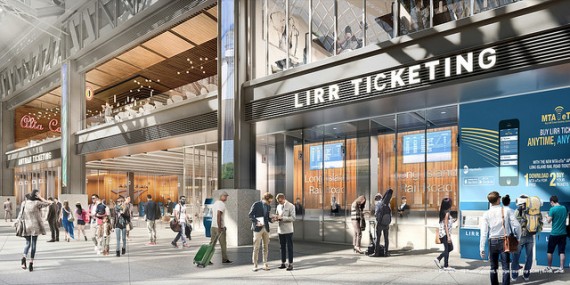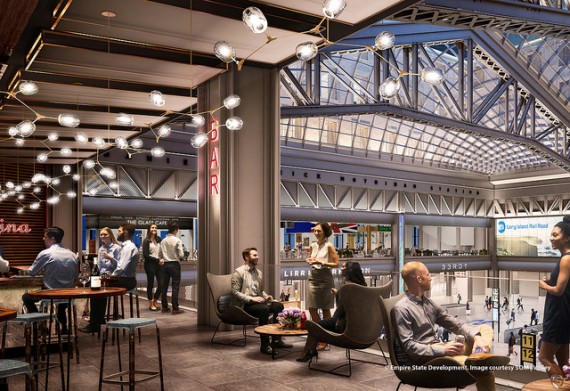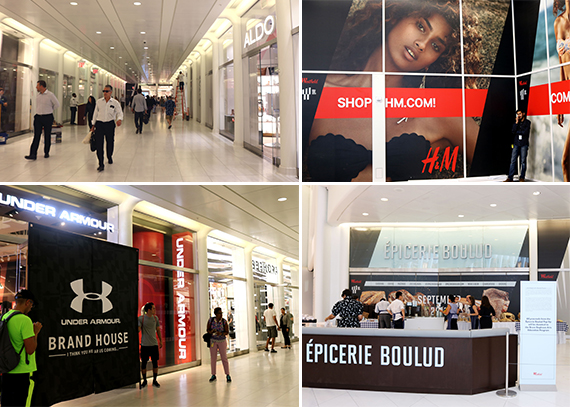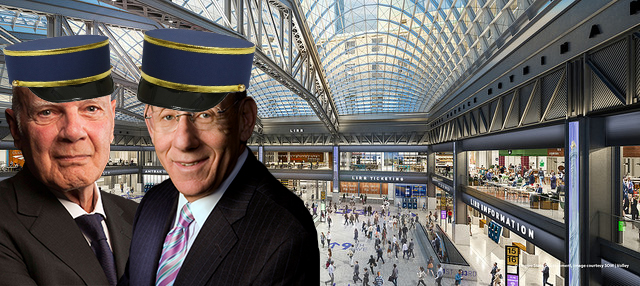The inscription that runs atop the James A. Farley Post Office’s Corinthian columns declares reliability and speed: “Neither snow nor rain nor heat nor gloom of night stays these couriers from the swift completion of their appointed rounds.”
It’s a somewhat ironic mantra for a building that represents two decades-worth of redevelopment false-starts. Since the 1990s, politicians have envisioned a grand train hall for the Beaux Arts building — only to see the plans languish as prominent developers and politicians tried and failed to lure tenants to the post office. At different times, Madison Square Garden, a community college, CBS and most recently, General Electric were potential suitors — all of whom ultimately demurred at the State of New York’s advances.
 Now, the latest plans for the landmarked building call for the creation of more than 700,000 square feet of office and retail space and a 255,000-square-foot train hall. Gov. Andrew Cuomo announced last month that Related Companies [TRDataCustom] and Vornado Realty Trust will be redeveloping the building — known as Moynihan Train Hall — and contributing $600 million to the $1.6 billion project.
Now, the latest plans for the landmarked building call for the creation of more than 700,000 square feet of office and retail space and a 255,000-square-foot train hall. Gov. Andrew Cuomo announced last month that Related Companies [TRDataCustom] and Vornado Realty Trust will be redeveloping the building — known as Moynihan Train Hall — and contributing $600 million to the $1.6 billion project.
The developers have an edge in terms of experience — they were initially tapped to redevelop the building in 2005 before Cuomo restarted the project in January. They also have considerable stakes in the area: Vornado owns some 9 million square feet of office and retail space surrounding Penn Station, and Related is co-developing the largest private real estate development in U.S. history — Hudson Yards — to the west. In many ways, Farley will serve as a link between the developers’ biggest assets. Still, they face some headwinds in the form of competition from slick new buildings, a struggling Midtown market and some wariness about retail in major transit hubs.
Questions of demand
According to CBRE, the office availability rate in Midtown reached 11.7 percent in the second quarter of 2016. Beyond that, 4.1 million square feet of new office construction or major renovations are planned in Midtown. Over the next few years, an eye-popping 7.9 million square feet of office space is expected to become available in Midtown.
Since 2011, 43 tenants — totaling 6.9 million square feet — have moved out of Midtown or Midtown South buildings to Downtown, according to Colliers. Craig Caggiano, an executive director at the firm, said that Farley is competing against a slew of new projects for tenants who crave modern spaces — 10 Hudson Yards, Brookfield Office Properties’ One Manhattan West, the Moinian Group’s 3 Hudson Boulevard and the World Trade Center complex.
While the availability rates in Midtown and the level of new office construction in the area have some concerned, Caggiano said that the Farley space offers one unique, game-changing trait — it’s situated smack dab above one of the world’s busiest transit hubs and near a bevy of landmarks.
Related doesn’t seem concerned about the glut of office space and the level of competition it will face. A spokesperson pointed to leasing activity in Hudson Yards.
“The market has shown it can support new commercial and retail space,” the representative said. “The successful leasing efforts happening throughout the Hudson Yards district demonstrate that this is an area of the city where businesses, retailers and residents want to be.”
Crossing the tenant bridge
Farley sits in the borderlands of Midtown South and the Penn Plaza submarkets, and those who spoke to TRD said that the project will likely help link these two areas with the Far West Side.
Bill Edwards, senior vice president of Core Holdings at the Rockefeller Group, said the project will attract different tenants than the tech companies Vornado targets for Penn Plaza and the corporate titans Related woos to fill Hudson Yards.
“I think this particular project has the opportunity to kind of bridge both of those user gaps and attack the market at a different size range and a different tenant base,” said Edwards, whose company owns several large properties in Midtown. “Rather than focusing on a one-large user, I can see the strategy for this asset as a boutique office building. So the strategy could be, if you’re 600,000 square feet, it could be a 2,000 to 3,000 square foot [per] user.”
Edwards said that the 588,000 square feet of office space at Farley would likely command market-rate rents for new construction, which ranges from $80 to $100 per square foot. Average asking rents in Midtown South reached $68.9 per square foot in the second quarter of 2016, according to CBRE.
Cracking the retail question
As for the 112,000 square feet of retail planned for Farley, those who spoke to TRD said that the retail currently in Penn Station lags far behind stores found in other train stations. In other words, there’s a big opportunity to be had.
 Robin Abrams, executive vice president of retail consulting firm Lansco Corporation, pointed to Grand Central Terminal, Union Station in Chicago and St. Pancras in London as prime examples of major transit hubs working in concert with retail. She said the Long Island Rail Road and Amtrak passengers are a “captive audience” for the retail planned at Farley.
Robin Abrams, executive vice president of retail consulting firm Lansco Corporation, pointed to Grand Central Terminal, Union Station in Chicago and St. Pancras in London as prime examples of major transit hubs working in concert with retail. She said the Long Island Rail Road and Amtrak passengers are a “captive audience” for the retail planned at Farley.
“I think it’s a long time coming, and I think the potential is huge,” she told TRD.
The Empire State Development Corporation — the state agency that owns Farley — has said that the building’s retail tenant will not be a “big-box store” or “mart” of any sort, though it hasn’t specified what kind of company would be ideal for the space.

The Oculus at the World Trade Center on opening day
The challenges faced by a high-profile retail mall over a major transit hub and all the bureaucracy that comes with it might not inspire confidence. Take Westfield and the World Trade Center. The Australian real estate firm has sued several of its tenants for not moving into space at WTC mall, which opened in August with only 60 percent of its more than 100 stores ready to greet customers.
Soozan Baxter, of Soozan Baxter Consulting, said there are a few key differences between the project at Farley and the World Trade Center.
For one, foot traffic around the WTC is much lower than what will be in Farley. According to the Port Authority of New York and New Jersey, 250,000 daily commuters pass through the WTC Transportation Hub. Penn Station has 650,000. Baxter also noted that Westfield didn’t have the level of experience that Vornado and Related bring to the table.
“They are not living breathing and dying New York the way Related and Vornado are,” she said. “Westfield does a very good job building malls across the America, but Manhattan is a different animal.”
It’s not clear what sort of retailers the building will attract, though Cuomo indicated that Farley will feature “world-class dining and shopping.” Baxter said the building won’t likely lure high-end, international brands.
“You don’t want to shoot too high,” she said. “I don’t think most people do luxury shopping in a train station.”
